the bright midday sun poked through a thinning wall of ponderosa pines as we shuffled 180 degrees around a sharp switchback. The treeline — the point of elevation above which the environment is no longer suitable for most plants to survive — was 100 feet above my head. Drawing nearer, I realized we were surrounded on two sides by cliffs dropping over 100 feet in places to the open bowls of snow and rock below.
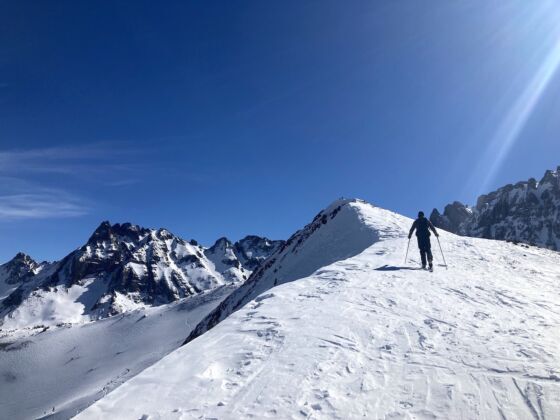
I'm an Advanced Skier but Tried Skiing With a Guide Anyway. Here's Why I Loved It.
Stopping for a gasp of air (and a drink of water), my guide, Bill Allen, offered a choice. We could proceed just a little further and drop into a backcountry ski run to our right through an open bowl of crusty powder. Or, we could wind around the back of the upcoming peak and drop in on the other side where a steep-but-short couloir would drop us into a wide-open field of softer snow.
We’d been uphill skinning for three hours. I’d strapped synthetic skins (hence the name) to the bottom of my split snowboard to create traction so I could move uphill without sliding back down. But carrying half a snowboard on each leg was hard and my legs were beginning to ache. And my heart was racing. No matter how many days I spend above treeline, the potent mixture of direct sunlight, thin air, and a rapid-fire heartbeat always catches me by surprise.
Despite my encroaching fatigue, we opted for the longer approach to guarantee a better run down. I had joined Bill, co-owner of tour operator Mountain Trips, on a backcountry ski day tour organized by 57Hours, an adventure app that connects travelers to backcountry guides across the country.
“I’m about even in skills and knowledge with my usual backcountry partners, so our collective knowledge takes a major hit when we travel somewhere new. 57Hours solves that problem.” – Writer
My guide’s helpfulness began before even strapping on our skis
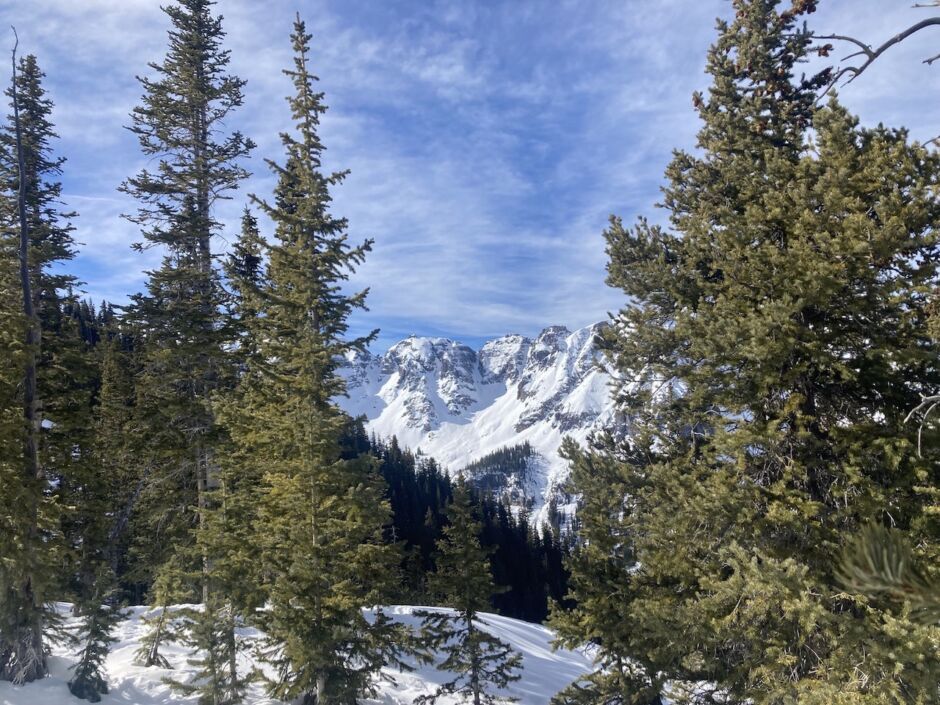
Photo: Tim Wenger
Bill and I met at a trailhead in Ophir, a tiny mountain town outside of Telluride, Colorado, at 8 AM. Our original plan had been to shuttle to a different trailhead, myself and my backcountry ski gear hopping into his truck before returning at the end of the day. But due to promising conditions in the mountains of the nearby trailhead and an avalanche report that looked favorable on all but the west-facing slopes, Bill brought up the idea of touring from our meeting point. Multiple options for adventurous couloir runs awaited, he said, and we’d have more access to line choices that looked good and safe, rather than being fully committed to the one path we’d have to take to end up here from the other trailhead.
I didn’t argue.
We did a beacon check, a process to test each person’s avalanche beacon to ensure it’s working correctly and has sufficient battery life. Then, we hit the trail for what Bill expected to be a three-hour climb.
Three hours of uphill touring to access a long downhill run from the top of a peak is a decent excursion and a big commitment for an average-level backcountry skier. But many popular backcountry runs in Colorado are accessible via a climb of two hours or less.
Why a 57Hours guide is useful for even experienced skiers

Photo: Tim Wenger
I’d done tours requiring this long of a climb before. But because I had never toured in this section of the San Juan Mountains known as the Nevada Zone, having a local expert like Bill leading the way helped me feel more comfortable taking a steeper line down and making key decisions on the fly. 57Hours partners with his outfit to take adventurers visiting Telluride on guided backcountry expeditions. Because Bill lives and guides in the area, his knowledge of terrain quality and safety based on variables like recent snowfall, time of day, and weather conditions, proved invaluable.
Even after checking the day’s avalanche report, I tend to be conservative when choosing backcountry ski lines unless I’m in a zone I know very well in low-risk conditions. Having Bill’s knowledge ensured that our group picked a fun and worthwhile route down and did it as safely as possible. Of course, there are inherent risks involved in backcountry skiing, but local knowledge, proper planning, and a willingness to change the plan based on in-field evaluation minimize those risks. I can tell now from doing both guided and unguided trips that having a guide lead the discussion and decision-making process is the best way to manage group decisions.
I also tend to ride with only a select few partners in the backcountry. I won’t enter the backcountry with anyone unless they have a beacon, shovel, and probe. I’ve taken several avalanche awareness and education courses through the American Institute for Avalanche Research and Education (AIARE), and prefer to tour with partners who have completed at least the first level of training. In the very rare case that a skier is buried in an avalanche, the responsibility of finding that person relies entirely on the skills and knowledge of the non-buried skiers.
I prefer to be the least-experienced person in the group, even if that sounds a bit counterintuitive. I’m about even in skills and knowledge with my usual backcountry partners, so our collective knowledge takes a major hit when we travel somewhere new. 57Hours solves that problem by pairing backcountry travelers with local guides to fill in the information and geography gaps.
Our guide found perfect views and a perfect downhill line
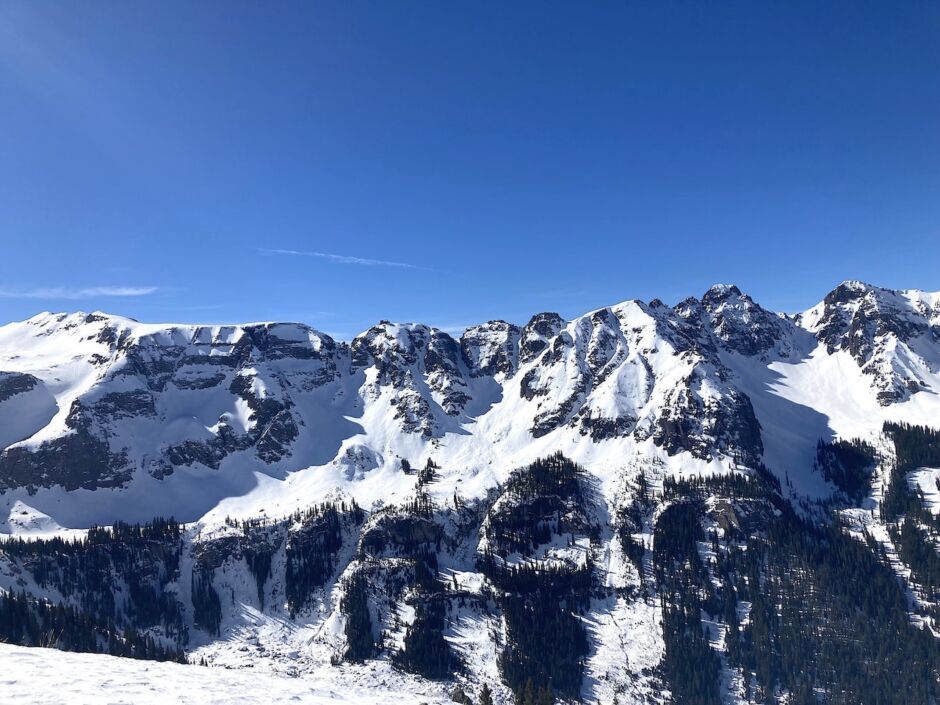
Photo: Tim Wenger
Two more switchbacks put us well above treeline. The jagged San Juan Mountain peaks, formed of volcanic rock, encircled us on three sides as though we were in a massive, rock-lined amphitheater (at 12,000 feet above sea level, no less). We circumnavigated the peak’s summit and stopped above a couloir on the far side, where we transitioned from our uphill setups to our downhill setups. As a splitboarder, this meant stripping the skins from the bottom of my splitboard and reconnecting the two halves to form a complete snowboard. I stuffed the skins into my backpack, and swapped out my beanie for a helmet and sunglasses for goggles.
Looking over the edge into the couloir, I was suddenly gripped by nervous excitement. My goggles fogged as moisture dripped from my right eye. The run was steep, well above the 30-degree incline that signifies an increased avalanche risk. We came up with a plan, and Bill headed down first to test the snow and identify a safe stopping point.
I dropped in next, hopping down a couple of feet to reach the lowest-impact entry point. The further to the right I looked, the more the drop into the run increased, eventually reaching around 10 feet at the far side. Now just inside the narrow, snow-filled gully, I looked back up at where I’d just come from. It’s then I noticed that Bill was at the bottom with his phone out, filming my descent.
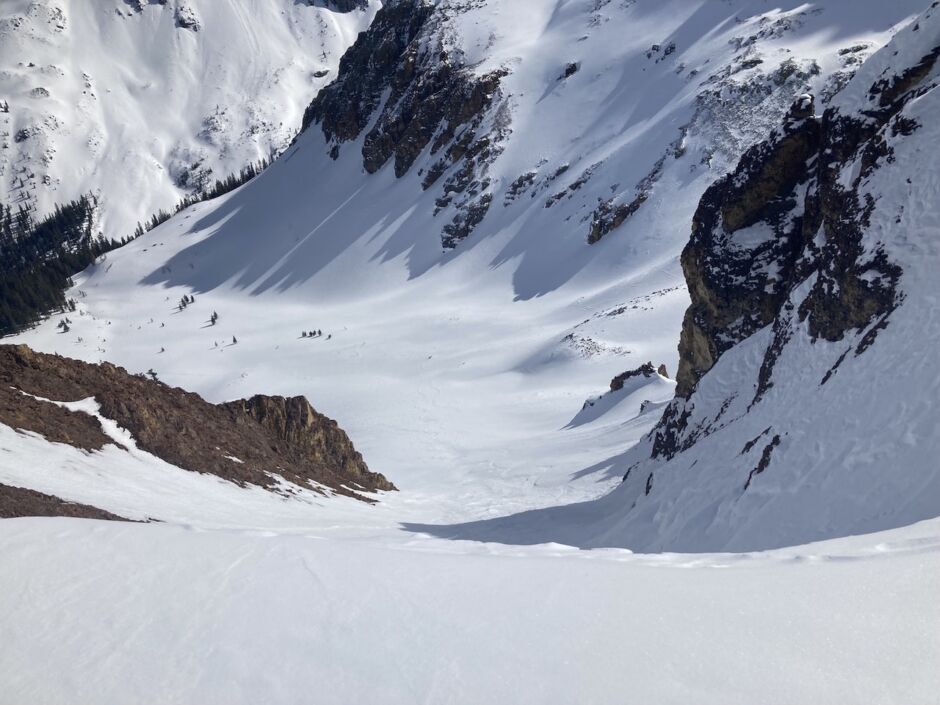
The view looking down just before dropping in // Photo: Tim Wenger
I hopped a quick 180 turn and slowly began to ski toward the left rock wall, making tight turns to zig-zag my way down the narrow chute. I probably made about seven or eight turns, gaining speed and confidence as I neared Bill at the bottom. My smile was ear-to-ear as I pulled up next to him, where we slapped a high-five and commented on the fantastic snow quality — Bill definitely knew the best spot to go.
From there, the next section was equally amazing. Below us sat a wide-open field of powder with a lower avalanche risk because of its less-angled slope. It would carry us most of the way down, eventually hitting a snow-covered access road leading back to the trailhead.
“Time to let ‘er rip,” Bill said.
He dropped first, his skis effortlessly carving turns through the snow, forming an S-shaped line through the bowl before dipping into the forest below. When he reached a safe stopping point near the edge of treeline, he lifted a ski pole in the air to signal that it was my turn to drop in.
I followed just to the right of his line, my splitboard turns longer and wider than his ski turns. The tracks of my snowboard across his ski tracks created a beautiful helix shape in the snow that called for an unapologetically exuberant “Whooooo!” when we saw it from below. Our lines carved two passion-fueled ribbons from the couloir into the bowl, making tiny marks in an otherwise uninterrupted blanket of white.
“This is what snowboarding is all about,” I thought to myself as we proceeded through the trees. “This is why I hike up mountains in the middle of winter, even when it’s so much easier to hop on a chairlift.”
We traversed the snowed-over road slowly, though I had to unstrap one foot in a few sections to push myself along. Fortunately, the motivation was cold beers waiting in the bed of my truck. Handing one to Bill after unstrapping, I found myself envious of his job but thankful for his company. Without it, I’d never have found this trailhead or known where to turn to find the best snow. With his guidance, we’d planned and executed a full-day tour in an area I’d never been to. And we’d done it safely while making decisions on the fly to ensure the best route down. It was adventure riding in the truest sense.
How does 57Hours work?
If you’ve ever booked a guided tour on vacation before, using the 57Hours platform works similarly. The website prompts users to search for adventures based on location, then displays available tours in that area. To book this Telluride tour, I selected “Backcountry Skiing in Telluride” from the options displayed, and proceeded to select the date that worked for me.
Once confirmed, 57Hours connected me with Mountain Trips. I received a phone call from Bill Allen, my guide, to discuss what I wanted out of the tour, including length, difficulty, and whether or not I needed rental gear, which is available for activities that require it.
The day before the trip, 57Hours sent out an email with details on what to expect and an itinerary. Day of, I received a handy email about gratuity that even included a calculator so I knew how much to tip based on the cost of the trip.
The experience was smooth and easy, and saved me a bunch of time that would have otherwise gone into researching local guides in Telluride and finding a backcountry tour that met my needs.
Learn more about 57Hours Telluride backcountry ski tours
Heading to Telluride on a ski trip? Check out Matador’s guide to the best Airbnbs near Telluride.
Gear I used on my tour with 57Hours
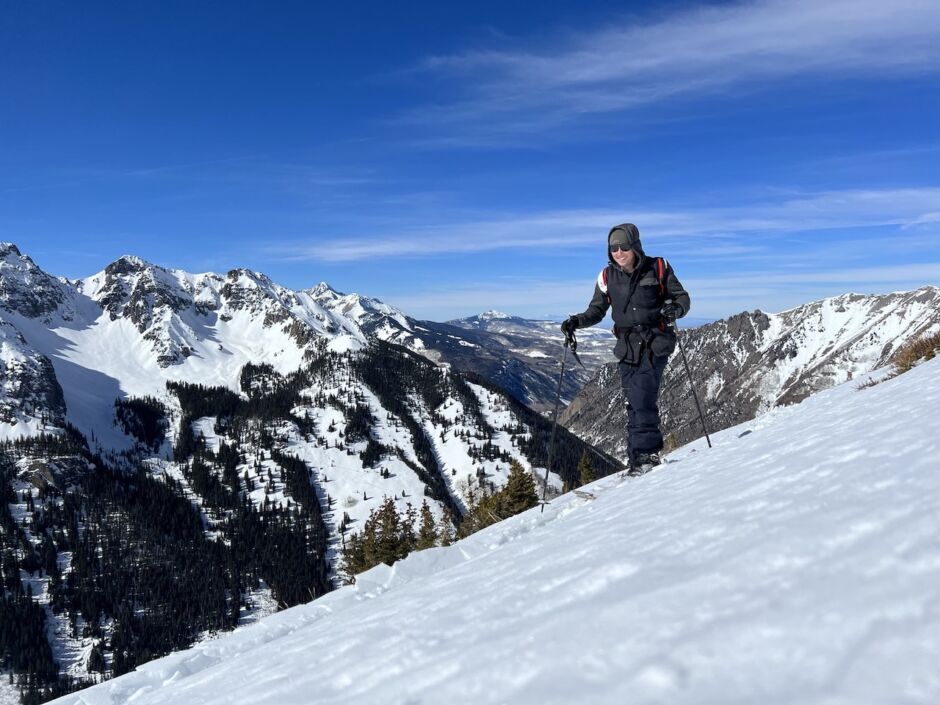
Credit: Bill Allen
We hope you love the backcountry snowboard gear we recommend! Just so you know, Matador may collect a small commission from the links on this page if you decide to make a purchase. Listed prices are accurate as of the time of publication.
Proper backcountry use involves a dedicated lineup of gear, including skis or a snowboard, poles, a helmet and more. It’s quite expensive to buy new, so if it’s not in your budget, you may be able to rent all your backcountry ski and snowboard gear from a local outdoor shop or REI location. Guiding companies can sometimes arrange your rentals, too.
But if you’re ready to buy, here’s my gear stack as a starting point for building our your own touring set-up.
Backpack: USWE POW Series 25L ski and snowboard touring pack
Price: $249.95
Splitboard: Jones Snowboards (I ride a Jones Explorer 156)
Price: $749.95-$1,399.95
Bindings: Spark R&D Blaze splitboard bindings
Price: $285
Poles: Black Diamond Equipment Vapor Carbon Ski Poles
Price: $112.46
Beacon Backcountry Access Tracker 2 Avalanche Beacon
Price: $299.95
Shovel: Yukon Charlie’s Collapsible Shovel
Price: $32.78
Probe: K2 BCA Stealth 270 Avalanche Probe
Price: $59.95